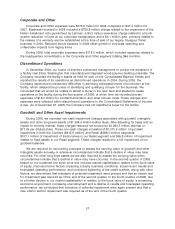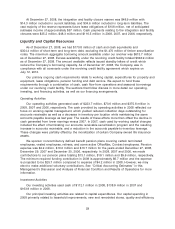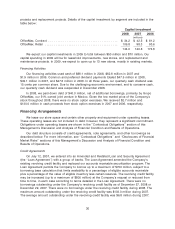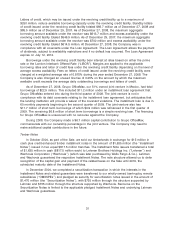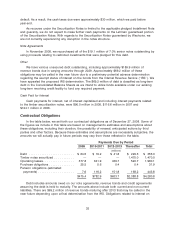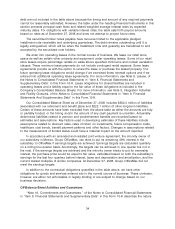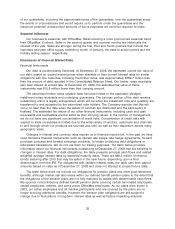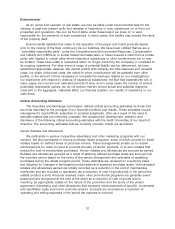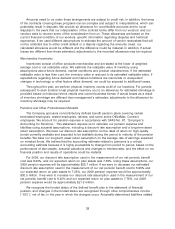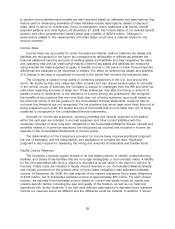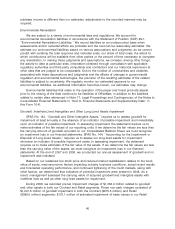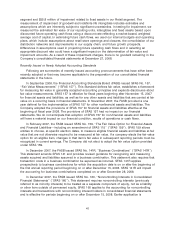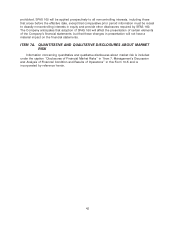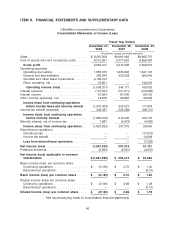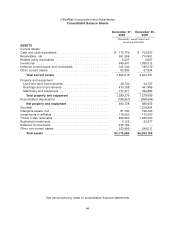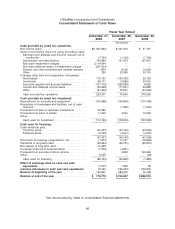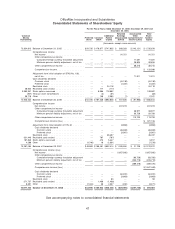OfficeMax 2008 Annual Report Download - page 41
Download and view the complete annual report
Please find page 41 of the 2008 OfficeMax annual report below. You can navigate through the pages in the report by either clicking on the pages listed below, or by using the keyword search tool below to find specific information within the annual report.Environmental
As an owner and operator of real estate, we may be liable under environmental laws for the
cleanup of past and present spills and releases of hazardous or toxic substances on or from our
properties and operations. We can be found liable under these laws if we knew of, or were
responsible for, the presence of such substances. In some cases, this liability may exceed the value
of the property itself.
Environmental liabilities that relate to the operation of the paper and forest products assets
prior to the closing of the Sale continue to be our liabilities. We have been notified that we are a
‘‘potentially responsible party’’ under the Comprehensive Environmental Response, Compensation
and Liability Act (CERCLA) or similar federal and state laws, or have received a claim from a private
party, with respect to certain sites where hazardous substances or other contaminants are or may
be located. These sites relate to operations either no longer owned by the Company or unrelated to
its ongoing operations. For sites where a range of potential liability can be determined, we have
established appropriate reserves. We cannot predict with certainty the total response and remedial
costs, our share of the total costs, the extent to which contributions will be available from other
parties, or the amount of time necessary to complete the cleanups. Based on our investigations;
our experience with respect to cleanup of hazardous substances; the fact that expenditures will, in
many cases, be incurred over extended periods of time; and in some cases the number of solvent
potentially responsible parties, we do not believe that the known actual and potential response
costs will, in the aggregate, materially affect our financial position, our results of operations or our
cash flows.
Critical Accounting Estimates
The Securities and Exchange Commission defines critical accounting estimates as those that
are most important to the portrayal of our financial condition and results. These estimates require
management’s most difficult, subjective or complex judgments, often as a result of the need to
estimate matters that are inherently uncertain. We reviewed the development, selection and
disclosure of the following critical accounting estimates with the Audit Committee of our board of
directors. The accounting estimates that we currently consider critical are as follows:
Vendor Rebates and Allowances
We participate in various cooperative advertising and other marketing programs with our
vendors. We also participate in volume purchase rebate programs, some of which provide for tiered
rebates based on defined levels of purchase volume. These arrangements enable us to receive
reimbursement for costs incurred to promote the sale of vendor products, or to earn rebates that
reduce the cost of merchandise purchased. Vendor rebates and allowances are accrued as earned.
Rebates and allowances received as a result of attaining defined purchase levels are accrued over
the incentive period based on the terms of the vendor arrangement and estimates of qualifying
purchases during the rebate program period. These estimates are reviewed on a quarterly basis
and adjusted for changes in anticipated product sales and expected purchase levels. Volume-based
rebates and allowances earned are initially recorded as a reduction in the cost of merchandise
inventories and are included in operations (as a reduction of cost of goods sold) in the period the
related product is sold. Amounts received under other promotional programs are generally event-
based and are recognized at the time of the event as a reduction of cost of goods sold or
inventory, as appropriate, based on the nature of the promotion and the terms of the vendor
agreement. Advertising and other allowances that represent reimbursements of specific, incremental
and identifiable costs incurred to promote vendors’ products are recorded as a reduction of
operating and selling expenses in the period the expense is incurred.
37


